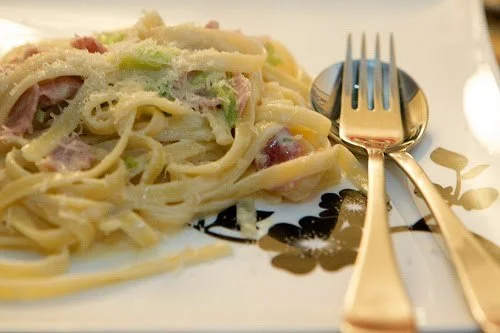My Version of Fettuccine Carbonara
Italian food is comforting, and this dish really raises the bar; creamy, cheesy, hearty and luxurious.
Fettuccine or Fettucini? The former spelling is technically correct, the latter is more commonly accepted. However you spell it, it's some really good stuff. Before Italian food snobs launch their attack on my recipe, note the title. This is My Version of the classic Italian dish that’s been around since the 1950s. But it is not a traditional version. True Fettuccine Carbonara has no cream. The root for Fettuccine Carbonara is Fettuccine Alfredo, which is little more than the pasta, butter, Parmesan cheese and some of the pasta water to aid in making the sauce. Carbonara adds bacon or pancetta, peas and sometimes, egg yolks. I found that making this dish with cream adds a luxurious depth to the traditional recipe, and so this is my tried and true version.
Pancetta is an Italian bacon that is cured with salt, pepper, and other spices. Unlike American bacon, which is taken from the sides and belly of the pig, typically smoked and cut into slices, pancetta comes only from the belly, is salt-cured but not smoked, and is generally sold rolled up into sausage shapes.
If you find pancetta cubetti, (which is pancetta that has been already cut into small cubes), this is an ideal labor-saver. But the recipe works great with American bacon, too. I can whip up this dish in about fifteen minutes if I'm using fresh pasta, like Buitoni, which you can generally find in your grocer's refrigerated pasta section. But dried pasta is perfectly acceptable. In fact, you don't really even have to use fettuccine. I frequently substitute linguini. A friend of our uses bucatini, which is a long slender pasta tube. I think any flat or thick round pasta will work, but shy away from more delicate pasta such as angel hair. This is a thick sauce that demands a pasta with enough strength to stand up to it.
My Version of Fettuccine Carbonara

Ingredients
- 2 9-oz containers fresh fettuccine or linguini (like, Buitoni)
- 8 tbsp butter (1 stick)
- 2 - 1/2 cups heavy cream
- 2 - 1/2 cups grated Parmesan cheese (like, Kraft)
- 2 egg yolks
- 1 cup frozen green peas, defrosted in the microwave
- 4 oz cubed pancetta or diced American bacon, fried crisp and drained
- 1/16 tsp fine sea salt
- table salt for boiling the pasta
- freshly ground pepper to taste
- pinch Hawaiian Black Lava salt (like, The Spice Lab)
- freshly shaved Pecorino-Romano cheese for garnish
Instructions
- Melt the butter in a saucepan over medium heat.
- Whisk in the heavy cream and keep whisking frequently to prevent burning. Slowly bring the cream to a point where it is hot and giving off steam, but not boiling.
- Using your whisk, stir in a little of the grated Parmesan cheese at a time, allowing it to melt into the mixture before adding more. The sauce will gradually thicken.
- Temper your egg yolks by putting them in a small mixing bowl and pouring a teaspoon of the hot cream mixture into the yolks, stirring constantly. Add two of three more teaspoons of cream to the yolks, which is bringing them up to a temperature so they don't turn into scrambled eggs when you introduce them to the saucepan.
- Once you have properly tempered the egg yolks, pour them into the saucepan with the cream and melted cheese, whisking all the while.
- Allow the cream mixture to come back to temperature and just under the boiling point while whisking. The egg yolks will gradually thicken the sauce even more. Remove the sauce pan from the heat and season with salt and pepper.
- In the meantime, cook whatever pasta you're using according to the package directions of al dente. Whichever pasta you're using, be sure to liberally salt the water. Drain well through a colander.
- In a large mixing bowl, add the pasta, the bacon or pancetta and the sauce. Using a large pasta spoon, constantly stir all ingredients to combine. The pasta will begin to absorb the sauce as you stir until you'll no longer have any residual sauce in the bottom of the mixing bowl.
- Add the peas last and give the mixture a stir to combine.
- Serve in large pasta bowls, with some freshly shaved Pecorino-Romano cheese, a pinch or two of Hawaiian Black Lava Salt and more freshly cracked black pepper on top.
Notes
- Note that in high altitudes above 5,000 feet, water boils at a slightly lower temperature and therefore is absorbed by the pasta at a slightly slower pace than at sea level. If above 5,000 feet, add two minutes to the cooking time.

